light GMC JIMMY 1997 Owner's Manual
[x] Cancel search | Manufacturer: GMC, Model Year: 1997, Model line: JIMMY, Model: GMC JIMMY 1997Pages: 410, PDF Size: 20.03 MB
Page 10 of 410
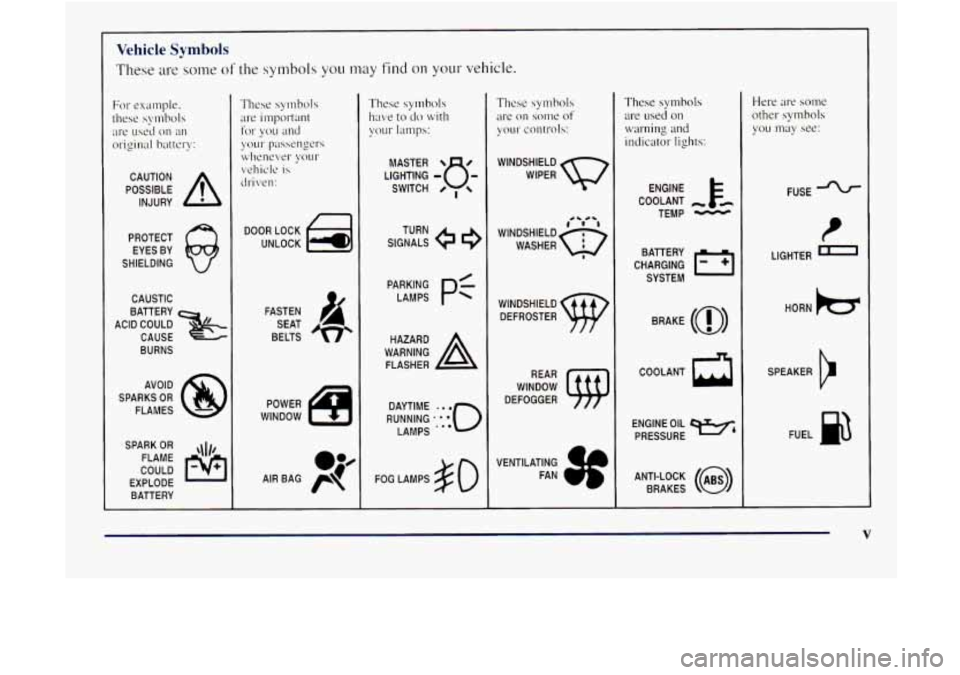
~~~~ Vehicle Symbols
These are some of the symbols you may find on your vehicle.
POSSIBLE A
CAUTION
INJURY
PROTECT EYES BY
SHIELDING
CAUSTIC
ACID COULD
&
BATTERY
CAUSE
BURNS
AVOID
SPARKS
OR
FLAMES
SPARK
OR ,\I/,
COULD FLAME
EXPLODE BATTERY
DOOR LOCK
UNLOCK
FASTEN SEAT
BELTS
POWER
WINDOW SIGNALS
e
TURN
RUNNING
.':o'o
DAYTIME LAMPS
..e
FOG LAMPS $0
These symbols
are on some of
your controls:
WINDSHIELD
WIPER
WINDSHIELD DEFROSTER
VENTILATING FAN
These symbols
are
used 011
warning and
indicator lights:
COOLANT
TEMP
CHARGING I-1
BAllERY
SYSTEM
BRAKE
(@)
COOLANT a
ENGINE OIL e,
PRESSURE
ANTI-LOCK
(@)
BRAKES
Here are some
other symbols
YOLI may see:
FUSE
t
LIGHTER m
HORN k3
SPEAKER
b
FUEL I&
V
Page 20 of 410
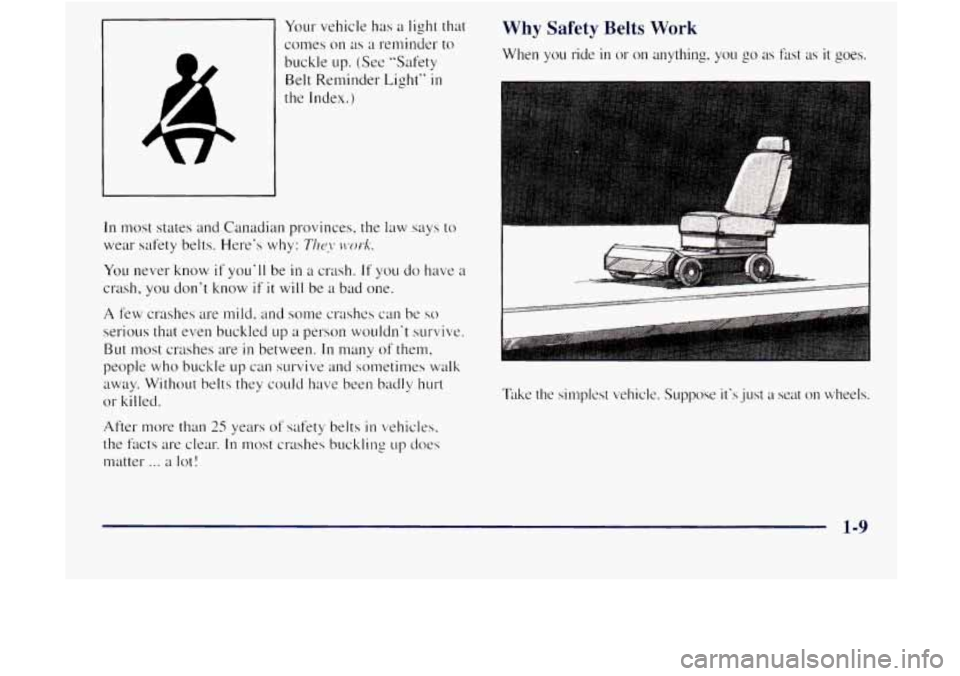
Your vehicle has a light that
comes
on as ;t reminder to
buckle up. (See “Safety
Belt Reminder Light” in
the Index.)
In most states and Canadian provinces, the law says to
wear safety belts. Here’s why: T~CJJ ~r~~r-k.
You never know if you‘ll be in a crash. If you do have a
crash, you don’t know if it will be a bad one.
A few crashes are mild. and some crashes can be so
serious that even buckled up a person wouldn’t survive.
But most crashes are
in between. In many of them,
people
who buckle up can survive and sometimes walk
away. Without belts they coulct have been badly hurt
or killed.
After more than
25 years of safety belts in vehicles,
the facts are clear.
In most crashes buckling up does
matter ... a lot!
Why Safety Belts Work
When you ride in or on anything, you go as fast as it goes.
L
Take the simplest vehicle. Suppose it’s just a seat on wheels.
1-9
Page 32 of 410
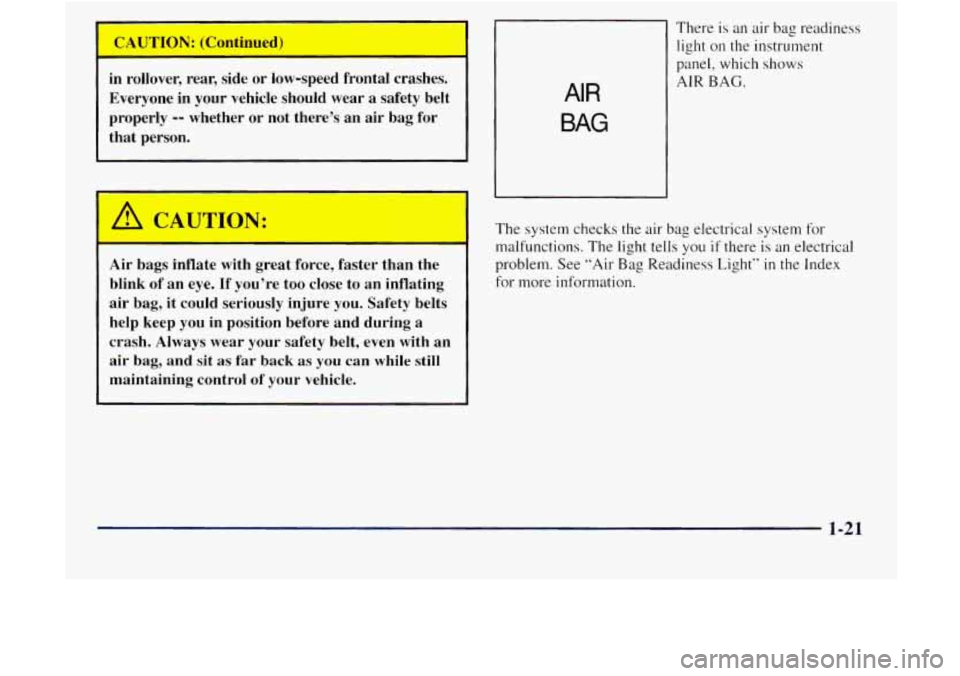
in rollover, rear, side or low-speed frontal crashes.
Everyone in your vehicle should wear a safety belt
properly
-- whether or not there’s an air bag for
that person.
I
/! CAUTION:
Air bags inflate with great force, faster than the
blink
of an eye. If you’re too close to an inflating
air bag, it could seriously injure you. Safety belts
help keep you
in position before and during a
crash. Always wear your safety belt, even with an
air bag, and sit as far back as you can while still
maintaining control of your vehicle.
I There is an air bag readiness
AIR
BAG
light on the instrument
panel, which shows
AIR BAG.
The system checks the air bag electrical system for
malfunctions. The light tells you
if there is an electrical
problem. See ”Air Bag Readiness Light”
in the Index
for more information.
- 1-21
Page 39 of 410
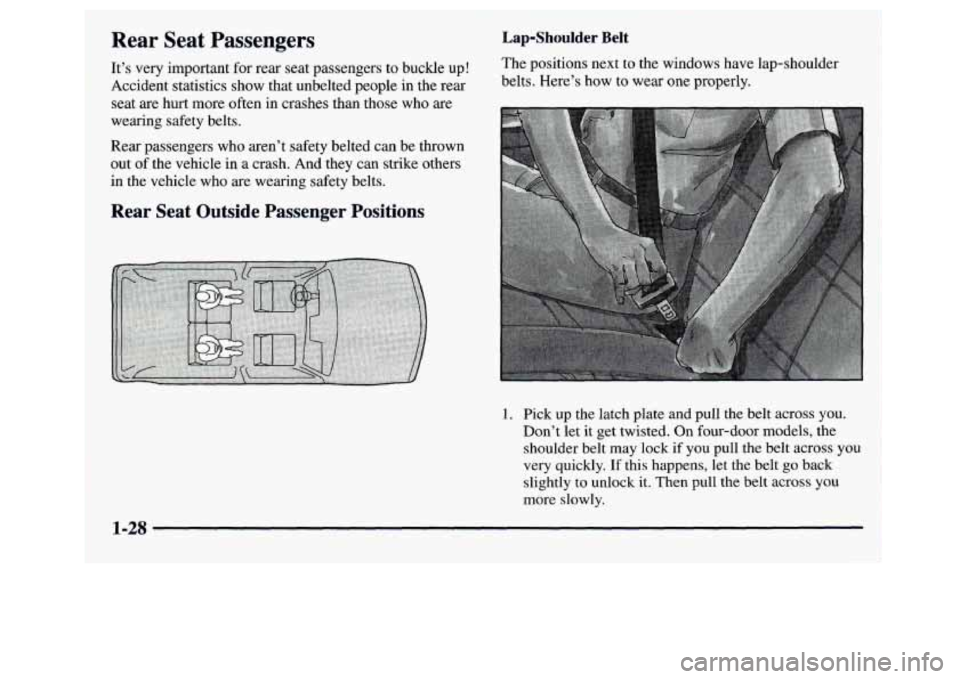
Rear Seat Passengers
It’s very important for rear seat passengers to buckle up!
Accident statistics show that unbelted people in the rear
seat are hurt more often in crashes than those who
are
wearing safety belts.
Rear passengers who aren’t safety belted can be thrown
out of
the vehicle in a crash. And they can strike others
in the vehicle who are wearing safety belts.
Rear Seat Outside Passenger Positions
Lap-Shoulder Belt
The positions next to the windows have lap-shoulder
belts. Here’s how to wear one properly.
1. Pick up the latch plate and pull the belt across you.
Don’t
let it get twisted. On four-door models, the
shoulder belt may lock if you pull the belt across you
very quickly.
If this happens, let the belt go back
slightly to unlock
it. Then pull the belt across you
more slowly.
1-28
Page 58 of 410

Safety Belt Extender
If the vehicle’s safety belt will fasten around you, you
should use
it.
But if a safety belt isn’t long enough to fasten, your
dealer
will order you an extender. It’s 1.1-ee. Whe,n you go
in to order it, take the heaviest coat you will wear, so the
extender
will be. long enough for you. The extender will
be just for you, and just for the seat
in your vehicle that
you choose. Don‘t let someone else use
it, and use it
only for the seat it is made to fit. To wear it. just attach it
to the regular safety belt.
Checking Your Restraint Systems
Now and then, make sure the safety belt reminder light
and all yo~~r belts, buckles, latch plates, retractors and
anchorages are working properly.
Look for any other
loose or
dan~aged safety belt system parts. If you see
anything that
tnighl keep a safety belt system from
doing its job, have it repaired.
Torn or frayed safety belts may not protect you
in a
crash. They can rip apart under impact forces. If a belt is
torn or I-i-ayed, get a new one right away.
Also look for any opened or broken air bag covers. and
have them repaired or replaced. (The
air bag system
does not need regular maintenance.)
Page 73 of 410
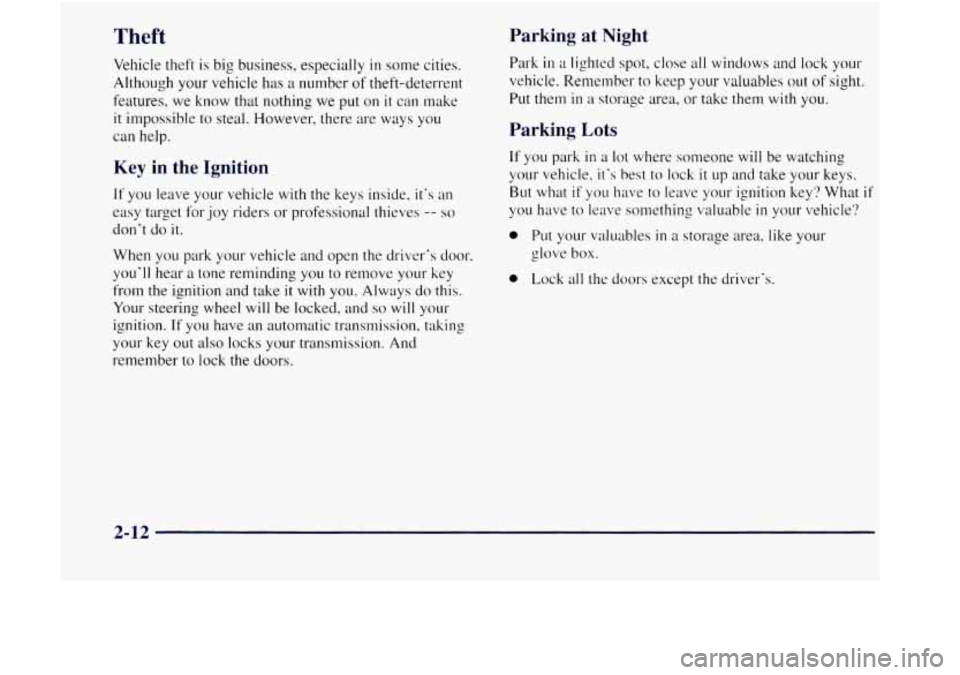
Theft
Vehicle theft is big business, especially in some cities.
Although
your vehicle has a number of theft-deter-rent
features, we know that nothing we put
on it can make
it impossible to steal. However, there are ways you
can help.
Key in the Ignition
If you leave your vehicle with the keys inside, it’s an
easy target for joy riders
or professional thieves -- so
don’t do it.
When you park your vehicle and open the driver’s door.
you’ll hear a tone reminding
you to remove your key
from the ignition and take it with you. Always do this.
Your steering wheel will be locked, and so will your
ignition.
If you have an automatic transmission, taking
your
key out also locks your transmission. And
remember to lock the doors.
Parking at Night
Park in a lighted spot, close all windows and lock your
vehicle. Remember
to keep your valuables out of sight.
Put them
in a storage area, or take them with you.
Parking Lots
If you park in a lot where someone will be watching
your vehicle,
i1.s best to lock it up and take your keys.
But what if ~OLI have to leave your ignition key? What if
you have to leave something \duable in your vehicle?
0 Put your valuables in a storage area, like your
2 Olove box.
0 Lock all thc doors except the driver’s.
2-12
Page 83 of 410
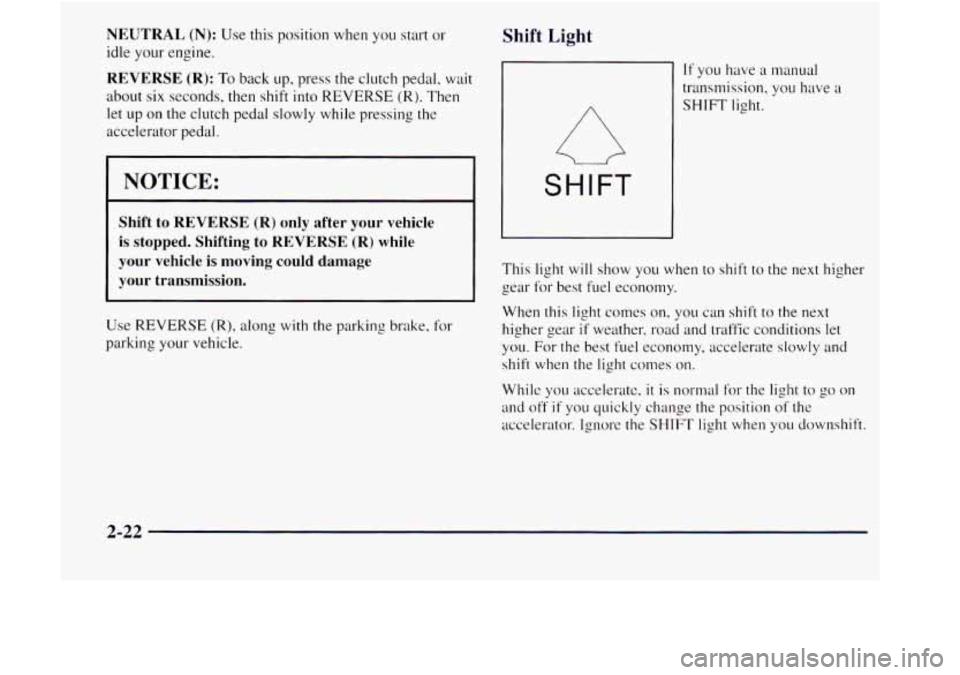
NEUTRAL (N): Use this position when you start or
idle your engine.
REVERSE (R): To back up, press the clutch pedal, wait
about six seconds, then shift into
REVERSE (R). Then
let
up on the clutch pedal slowly while pressing the
accelerator pedal.
I NOTICE:
Shift to REVERSE (R) only after your vehicle
is stopped. Shifting to REVERSE
(R) while
your vehicle
is moving could damage
your transmission.
Use REVERSE (R), along with the parking brake. for
parking your vehicle.
Shift Light
SHIFT
If you have a manual
transmission. you have a
SHIFT light.
This light
will show you when to shift to the next higher
gear for best fuel economy.
When this
light comes on, you can shift to the next
higher gear
if weather, road and traffic conditions let
you. For the best fuel economy, accelerate slowly
and
shift when the light comes on.
While you accelerate, it is normal for the light to go on
and off if you quickly change the position of the
accelerator. Ignore the
SHIFT light when you downshift.
2-22
Page 84 of 410
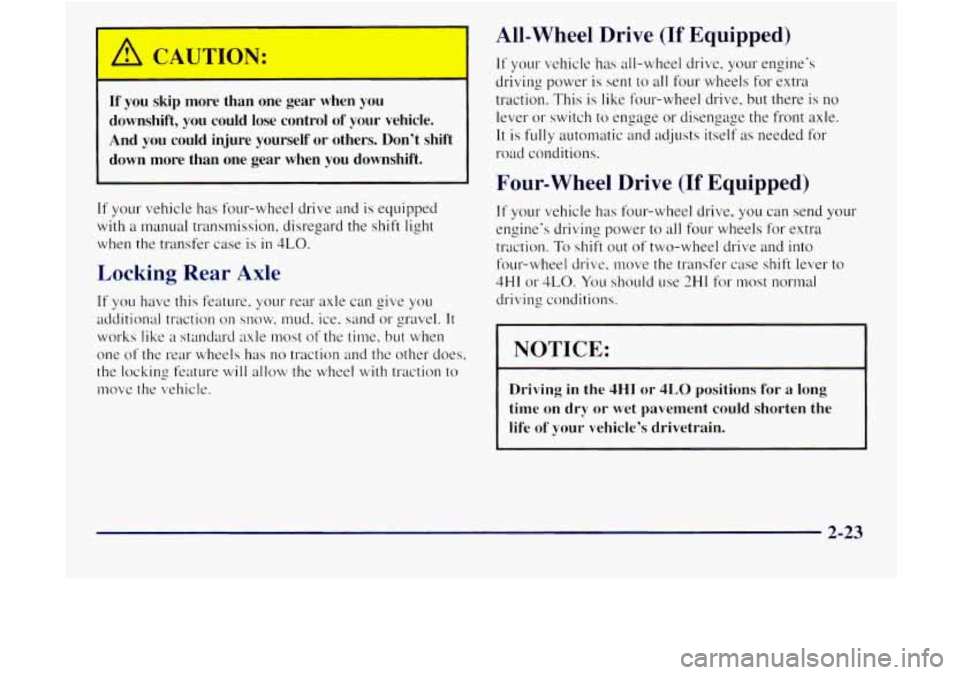
If’ you skip more than one gear when you
downshift, you could lose control
of your vehicle.
And you could injure yourself or others. Don’t shift
down more than one gear when
you downshift.
If your vehicle has four-wheel drive and is equipped
with a manual transmission. disregard the shift light
wlxn the transfer case is in 4LO.
Locking Rear Axle
If you have this feature. your rear axle can give you
additional traction
on sno\v, mud. ice, sand 01- gra~~l. It
works like a standard axle most of the time, but when
one of the rear nhxls has
no traction and the other does,
the locking feature
will allow the wheel with traction to
~nove the vehicle.
All-Wheel Drive (If Equipped)
If your \:chicle has all-wheel drive, your engine’s
driving power is sent to all four wheels for extra
traction. This is like four-wheel drive, but there is
no
lever or switch to engage or disengage the front axle.
It is fully automatic and adjwts itself as needed for
mid conditions.
Four-wheel Drive (If Equipped)
If your vehicle has four-wheel drive, you can send your
engine’s driving power
to all four wheels for extra
traction.
To shift out of two-wheel drive and into
four-wheel drive, move the transfer case shift lever to
4HI or 4LO. You should use ?HI for most normal
driving conditions.
1 NOTICE:
~~ ~~~~~ ~~ ~~~~
Driving in the 4HI or 41,O positions for a long
time on
dry or wet pavement could shorten the
life of your vehicle’s drivetrain.
2-23
Page 85 of 410
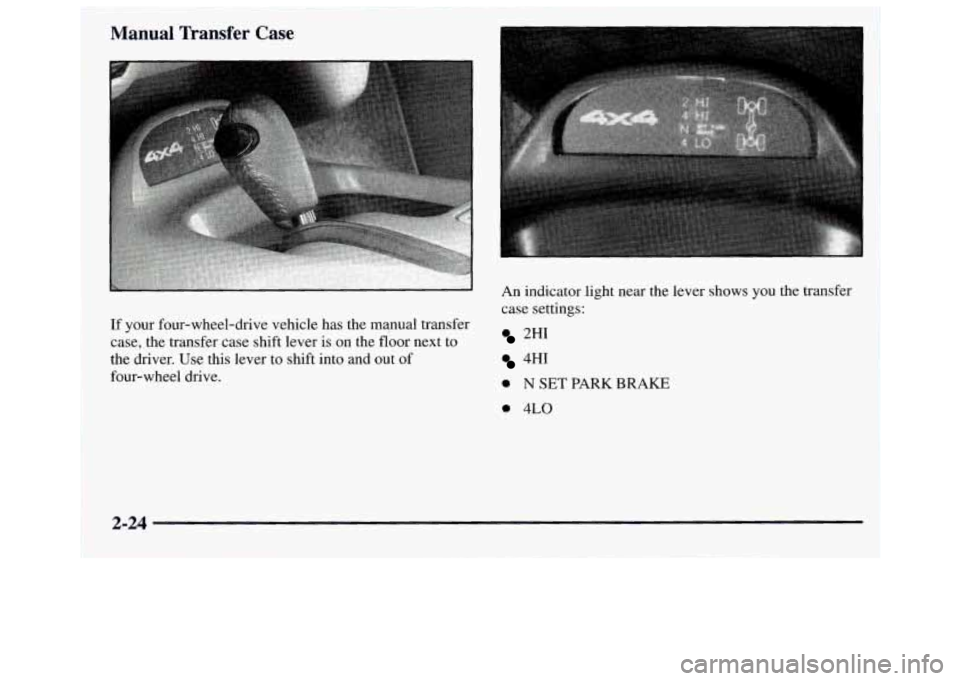
Manual Transfer Case
If your four-wheel-drive vehicle has the manual transfer
case, the transfer case shift lever is on the floor next to
the driver. Use this lever to shift into and out of
four-wheel drive. An indicator light near the lever shows
you the transfer
case settings:
2HI
4HI
0 N SET PARK BRAKE
0 4LO
2-24
I I
Page 86 of 410
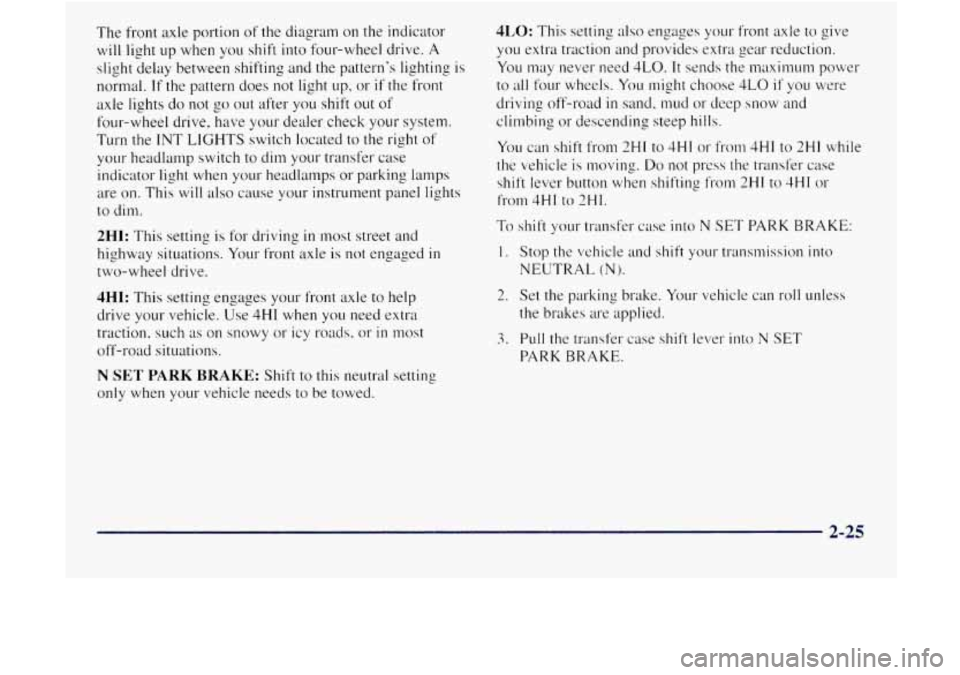
The front axle portion of the diagram on the indicator
will light up when you shift
into four-wheel drive. A
slight delay between shifting and the pattern's lighting is
normal. If the pattern does not light up, or if the front
axle lights
do not go out after you shift out of
four-wheel drive, have your dealer check your system.
Turn
the INT LIGHTS switch located to the right of
your headlamp switch to dim your transfer case
indicator light when your headlamps or parking lamps
are on. This
will also cause your instrument p.anel lights
to dim.
2HI: This setting is for driving in most street and
highway situat.ions. Your front axle
is not engaged in
two-wheel drive.
4HI: This setting engages your front axle to help
drive
your vehicle. Use 4H1 when you need extra
traction. such
as on snowy or icy roads. or in most
off-road situations.
N SET PARK BRAKE: Shift to this neutral setting
only when your vehicle needs to be towed.
4LO: This setting also engages your front axle to give
you extra traction and provides extra gear reduction.
YOLI may never need 4LO. It sends the maximum power
to all four wheels. You might choose 4L0 if you were
driving off-road
in sand, mud or deep snow and
climbing or descending steep hills.
You can shift from
2HI to 4H1 or from 4HI to 2HI while
the vehicle
is moving. Do not press the transfer case
shift lever button when shifting from
2HI to ;CHI or
from
4HI to 2HI.
To shift your transfer case into N SET PARK BRAKE:
1. Stop the vehicle and shift your transmission into
NEUTRAL
(N).
2. Set the parking brake. Your vehicle can roll unless
the brakes are applied.
3. Pull the transfer case shift lever into N SET
PARK BRAKE.
2-25